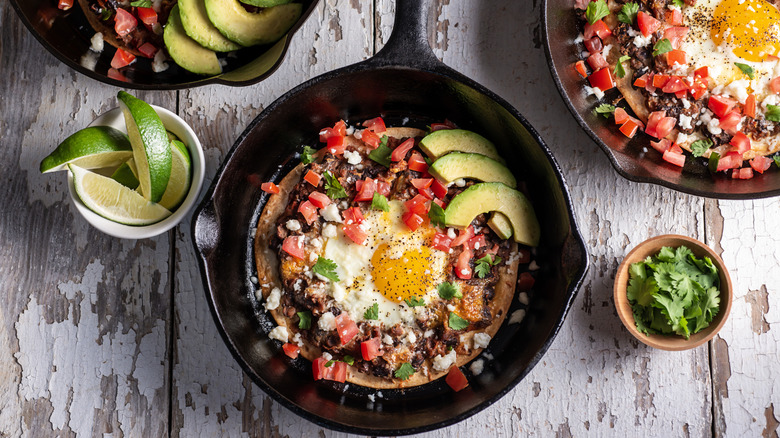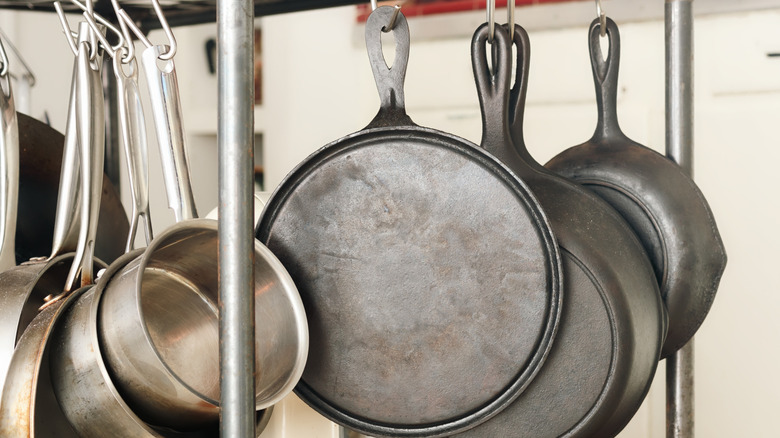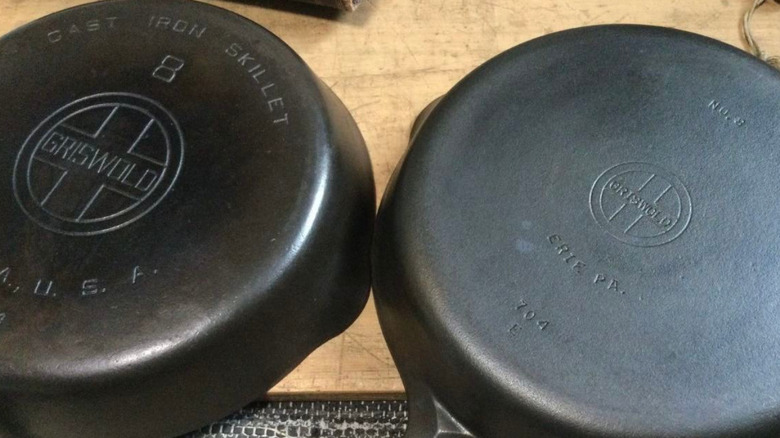The Unexpected Value Of Your Old Cast Iron Skillet
We may receive a commission on purchases made from links.
You never know what kinds of collections people will cook up, but some collections are actually capable of cooking. In fact, some old cast iron skillets are apparently as collectible as rare and valuable Pokémon cards.
Like old and valuable cookbooks (and maybe even the cookbook collector's holy grail), old cast iron lovers seek kitchen collectibles they can use and display. While even the most sought-after old cast iron skillets don't have a market value comparable to a mint-condition Illustrator Pikachu card, some old kitchen items are worth serious money. Die-hard cast iron collectors value old skillets at prices that are hot to the touch.
While valuable vintage Pyrex collectors may want to put their pieces in the oven or fridge, vintage cast iron skillet collectors may want to literally throw some irons in the fire. Some collectors are turning away from modern nonstick pans in favor of cleaning up old rusty gold to cook anew. Others find older, smoother-milled cast iron skillets to be better made than their modern, perhaps rougher, counterparts. Of course, some cast iron collectors may simply want pretty (and pretty heavy) cast iron pieces to use as culinary decor. Whatever the reason for the seasoned pan seeking, old cast iron collectors are committed to the hunt for legendary pieces — and might just feel compelled to catch 'em all.
A mini skillet-sized history of cast iron
Cooks have been using cast iron cooking utensils since the third century, B.C. The practice of cooking up some grub in the hardy metal began in China, and slowly made its way throughout the world via trade routes, and the sharing of cooking trade secrets.
By the 1400s, cast iron had made its way throughout Europe, and in the 1700s, the English began using cast iron for cooking, rather than just for artillery and architecture. As outdoor cook fires gave way to indoor stoves, cast iron cookware continued to evolve. By the 19th century, English manufacturing refinements achieved during the Industrial Revolution allowed for thinner cast iron vessels to be mass produced, and for the cast iron cooking "craze" to further spread.
The first working iron foundry in the United States hit the scene in 1642, in a river town just outside of Boston. The Saugus Iron Works is now a National Historic Site, and referred to by the park's website as "the birthplace of the American iron and steel industry." In 1642, The Saugus Iron Works cast "the Saugus pot," a pot-bellied all-purpose kettle that also holds the distinction of being the first utilitarian iron casting on U.S. soil. By the mid- to late 1800s, three leading American manufacturers of cast iron cookware had emerged: Griswold Manufacturing (from Erie, PA,) Wagner Manufacturing (from Sidney, OH,) and Lodge Manufacturing (from South Pittsburg, TN.) While these brand names may be recognizable to even non-collectors of cast iron cookware today, these names certainly cause collectors of heirloom skillets and other cast iron pieces to perk up — and sometimes, pay up.
Very valuable old cast iron skillets
Typically, cast iron made before 1957 is considered "vintage." These older pieces can command prices as juicy as the steaks and other proteins they're capable of cooking. Real cast iron rusts, and rust is not really an issue to the serious collector. You can try to identify second-hand cast iron you've scoured for at thrift stores and estate sales by carefully flipping the heavy cookware over.
Just like spotting rare and valuable coins, look for markings on the bottom of the pan that may help you identify the manufacturer, as well as the age and make of said skillet. Some series of skillet are more valuable than others. A modern Dolly Parton-stamped Lodge skillet might be worth more than its $25 asking price to a home cook, but a spider-stamped Griswold skillet is exceedingly rare, old, and ridiculously valuable. In August 2024, one Griswold spider skillet, also stamped with an all-caps "ERIE" for where the company was founded, sold for $10,000 at auction.
Other old cast iron skillets have sold for mouth-watering sums on online auction site, eBay. In December 2024, a vintage Griswold #14 skillet with a front-pour spot sold for $3,249, and a #13 with a slant logo sold for $2,799.99. A vintage Lodge #12 skillet sold for the respectable sum of $1,280, while a vintage Wagner Ware #13 skillet sold for $949 in November, 2024. Old skillets large, small, and strange can also be very valuable. For example, a small #80 Griswold double skillet sold for $399 in January 2025, and a massive 20" Griswold hotel-sized skillet sold for $1,799.


